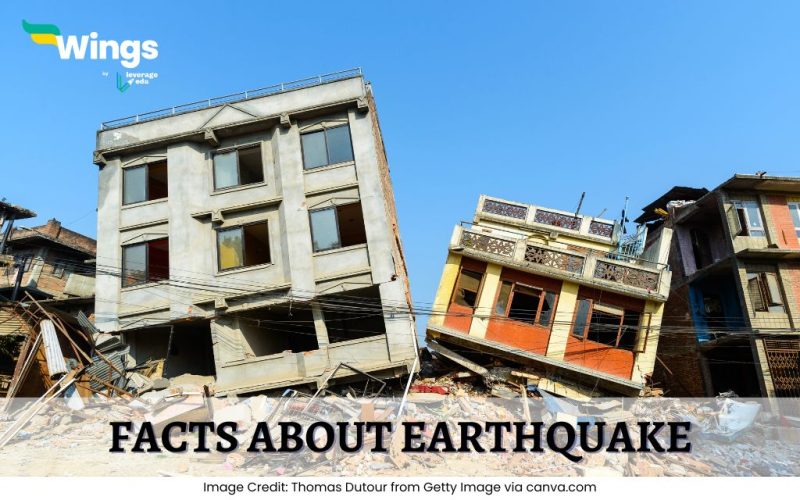Have you ever felt the ground shake and everybody run on open ground? That’s what happens during an earthquake! Earthquake facts tell us that earthquakes happen when there’s a sudden release of energy beneath the Earth’s surface, causing the ground to shake. Earthquakes are natural disasters that can cause a lot of damage, but understanding them helps us prepare for the worst-case scenario. In the meantime, here are some interesting facts about earthquake for kids to understand the science and be prepared for the unforeseen.
Table of Contents [show]
1. Earthquakes Happen Due to Movements Beneath the Earth’s Surface
Earthquakes occur when stress builds up in the Earth’s crust, causing rocks to slip suddenly along a fault. This releases energy in waves, making the ground shake. These movements happen because Earth’s tectonic plates are constantly shifting and interacting with each other.
2. Tectonic Plates Are Always Moving
The Earth’s surface is made up of giant pieces called tectonic plates, which are slowly moving. When these plates grind against each other, they create faults. Some faults experience tiny tremors constantly, while others store energy for centuries before releasing it as a big earthquake.

3. The Largest Earthquake Recorded Was a 9.5 Magnitude in Chile
The strongest earthquake ever recorded happened in Chile on May 22, 1960, with a magnitude of 9.5. It occurred on a fault that was nearly 1,000 miles long. Large earthquakes happen when faults extend deep into the Earth’s crust.
4. Some Earthquakes Happen Without Warning
Not all earthquakes occur on well-known faults. Some regions, like Alabama and Virginia, have experienced unexpected earthquakes. This shows that earthquakes can happen almost anywhere, even in places not known for high seismic activity.
5. Earthquake Waves Travel Through the Earth
When an earthquake occurs, energy moves through the Earth in waves. These waves cause the ground to shake and can travel long distances, which is why people can feel an earthquake even if they are far from the epicentre.
6. Earthquakes Can Trigger Tsunamis
When an earthquake happens under the ocean, it can displace huge amounts of water, creating giant waves called tsunamis. These waves can travel across entire oceans and cause massive destruction when they reach land.

7. Earthquakes Can Happen at Different Depths
Earthquakes can occur at various depths beneath the Earth’s surface, ranging from shallow to very deep. Most earthquakes occur in the Earth’s crust or upper mantle, typically within 15 miles of the surface. Some of the deepest quakes occur in areas where oceanic plates are pushed deep into the Earth’s interior, such as in subduction zones.
8. People Can Cause Earthquakes
Sometimes, human activities can trigger small earthquakes. This happens when waste fluids are injected deep into the Earth’s crust or large reservoirs are filled with water. While most of these earthquakes are small and cause little damage, some larger ones have been recorded. For example, oil and gas production has caused increased seismic activity in parts of the United States.
9. Soft Soil Can Make Earthquakes Feel Stronger
The type of soil underneath the ground can affect how strong an earthquake feels. When seismic waves travel through soft soil, they can slow down and grow larger, making the shaking stronger. In contrast, hard rock helps dampen the waves, making the shaking less intense. This means that areas with soft soil might experience stronger shaking than places on solid rock.

10. The Fastest Earthquake Wave is the P Wave
The P wave, also known as the primary or compressional wave, is the fastest earthquake wave. It moves by compressing and expanding the ground in the same direction it travels. This is why the P wave is the first to arrive at a location when an earthquake happens.
11. The Hypocenter is Where an Earthquake Starts
The hypocenter is the point beneath the Earth’s surface where the earthquake actually begins. This is where the fault line breaks and causes the energy that produces the shaking. The hypocenter is deep underground, far from where people usually feel the tremors.

12. You Can Plan Ahead for an Earthquake
You don’t need to wait for an earthquake to prepare for one. There are several steps you can take now to stay safe. For instance, you can learn first aid take CPR classes, and prepare an emergency kit with emergency food, water, medicines, and other essential items.
FAQs about Earthquake
The intensity of an earthquake is measured using the Modified Mercalli Intensity (MMI) scale. This scale helps to assess how strongly people feel the shaking and the damage it causes. Unlike magnitude, which measures energy release, intensity varies with location and the effects experienced by people.
India has several earthquake-prone areas, especially in the Himalayan region, northeastern states, and parts of Gujarat. Delhi, Kolkata, and Maharashtra are also at risk. These areas are near major fault lines, like the Himalayan Belt, making them vulnerable to earthquakes.
Earthquakes happen when there is a sudden release of energy from the Earth’s crust. This energy is caused by tectonic plates moving, and when these plates collide, slide past each other, or separate, it creates tension and causes the Earth to shake. This process happens at fault lines.
10 points about earthquakes include:
1. An earthquake is a sudden shaking of the ground.
2. It happens due to the movement of Earth’s tectonic plates.
3. Earthquakes release energy from the Earth’s crust.
4. The shaking is caused by seismic waves.
5. The point where an earthquake starts is called the hypocenter.
6. The epicentre is the point above the hypocenter.
7. Earthquakes can range from minor tremors to major events.
8. The magnitude measures an earthquake’s size.
9. The intensity measures how strong the shaking feels.
10. Earthquakes are common in places near tectonic plate boundaries.
An earthquake is special because it’s a natural event that occurs when the Earth’s plates shift and release energy. This energy travels as seismic waves, causing the ground to shake. Earthquakes can vary in size, from tiny tremors to massive quakes, and they shape landscapes over time, affecting buildings, roads, and even oceans.
The 7 causes of earthquakes include tectonic plate movements, volcanic activity, human activities (mining, drilling), meteorite impact, isostatic rebound, reservoir-induced seismicity, and faults such as cracks in the Earth’s crust.
Interesting Reads
We hope you like this blog on facts about earthquake for kids. If you want to read informative blogs on similar topics, make sure to stay tuned with Leverage Edu.
 One app for all your study abroad needs
One app for all your study abroad needs















 45,000+ students trusted us with their dreams. Take the first step today!
45,000+ students trusted us with their dreams. Take the first step today!
